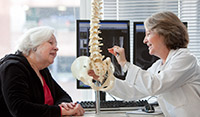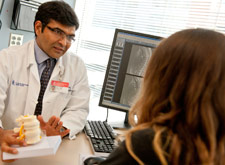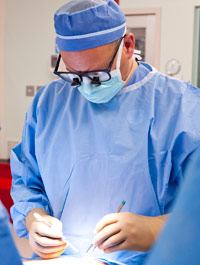Our Spine Care Services
Spine Treatment Does Not Always Require Surgery
Our patients benefit from a comprehensive evaluation and collaboration among spine specialists to select the optimum treatment.
 The Spine Center cares for adult patients with neck and back problems
including:
The Spine Center cares for adult patients with neck and back problems
including:
-
Conditions caused by aging
(degenerative disease):
- Lumbar and spinal stenosis
- Degenerative disc disease
- Herniated disc
- Osteoporosis and fragility/compression fractures of the spine
- Spondylolisthesis
- Central spinal cord compression (myelopathy) of the cervical and thoracic spine
- Problems with a spinal nerve root (radiculopathy) of the cervical, thoracic or lumbar spine
- Arthritis of the spine
- Tumors of the spine and spinal cord
- Spinal deformities such as scoliosis and kyphosis
- Spine trauma and spinal cord injuries
- Acute or chronic back and neck pain
Evaluation
-
 Complete musculoskeletal evaluation
Complete musculoskeletal evaluation
- Comprehensive medical imaging including MRI, CT scans, bone scans, X-rays and PET scans
- EMG/nerve conduction studies
- Neurology evaluation
- Evaluation for inflammatory arthritis
- Discography
Pain Management
- Injections (epidural injections, nerve root blocks, facet injections, dorsal rhizotomy, sacroiliac injections)
- Pain specialist consultation
- Spinal cord stimulators
- Radiofrequency ablation
Videos: Having a Spinal Injection
Physical Therapy
- Manual therapy
- Strengthening
- Range-of-motion and core exercises
- Aqua therapy
Spine Surgery
 Harnessing the most advanced
surgical techniques, Spine Center surgeons
treat all spine conditions from the base of the skull (cervical spine) to
the pelvis (lumbar spine).
Harnessing the most advanced
surgical techniques, Spine Center surgeons
treat all spine conditions from the base of the skull (cervical spine) to
the pelvis (lumbar spine).
Spine Center surgeons frequently perform:
- Minimally invasive decompression, fusion and instrumentation procedures (traditional open surgery performed when appropriate)
- Discectomy
- Laminectomy
- Laminoplasty
- Osteotomies for spinal deformity and treat scoliosis
The Spine Center at BIDMC provides the highest level of specialty care, and our surgeons are adept at revision surgeries for patients who have previously had surgery elsewhere and are experiencing problems, as well as comprehensive evaluation of new problems. BIDMC surgeons bring special expertise in:
- Minimally invasive decompression
- Minimally invasive instrumented fusion
- Minimally invasive anterior fusions in the lumbar spine (direct lateral interbody fusion)
For your convenience, the Spine Center at BIDMC can help you coordinate related services, including:
- Physical and occupational therapy
- Massage therapy
- Chiropractic care
- Acupuncture
A spinal cord stimulator is a treatment that helps some people who have chronic pain. Electrodes are placed in the epidural space in the back (an area that surrounds the spinal cord) and are connected to a “pulse generator.” The pulse generator sends electrical signals to the electrodes, which can help block pain signals in people with chronic pain. The strength and frequency of the electrical signals are controlled by the patient, using a remote device.
Will I Feel Electrical Signals from the Stimulator?
The electrical signals from spinal cord stimulation are not painful. Most patients report periodically feeling a gentle massage-like sensation or tingling feeling.
What Conditions Does a Spinal Cord Stimulator Treat?
Common reasons for recommending this treatment include:
- Chronic pain six months or more after spine surgery
- Reflex-sympathetic dystrophy, also known as chronic regional pain syndrome
- Nerve injuries
- Neuropathy
Patients with certain other pain syndromes, such as chronic nerve compression or post-stroke pain, are not good candidates for this treatment. Your doctor can explain more about whether or not spinal cord stimulation is likely to be an effective option for you.
How is a Stimulator Procedure Done?
There are two phases to having a spinal cord stimulator.
Doctors can give you a temporary device that you can try for a week or so to see if it works for you. The temporary device is placed during an outpatient procedure. An area of the back is numbed and electrodes are placed in the epidural space using needles. The doctor uses a special X-ray (fluoroscopy) to help guide the electrodes into the right place. The electrodes are then connected to a pulse generator, which you will wear attached to your clothing. You will be shown how to use a remote to control the signals going from the generator to the electrodes near your spine.
If the trial is effective in treating your pain, a permanent device can be implanted. This is done as an outpatient surgical procedure using sedation or general anesthesia. The temporary electrodes are replaced with permanent ones, and the pulse generator is implanted in your body, just under your skin. The implanted generator can be controlled with a remote, just as it was during the trial phase.
What are the Restrictions?
While you are wearing the temporary spinal cord stimulator device (about a week), you will need to take care not to bend, reach, or twist your body at the waist, as this could disrupt the position of the electrodes. During this time, you will not be able to lift anything more than five pounds. You will need to keep both the area where the lead was inserted and your pulse generator clean and dry.
For the permanent device, you will follow similar restrictions on bending and lifting for about one to two months, until the electrodes are well healed in your body. You will not be able to swim or get the area of the pulse generator wet for about a month.
Because there is metal in the pulse generator, you will not be able to have an MRI (magnetic resonance imaging) test, and you will need to alert screeners at airports and other secure areas that you have an implanted pulse generator.
How Effective is Spinal Cord Stimulation Treatment?
Not everyone gets the same results from spinal cord stimulation treatment. That is why the trial period is so important. For patients who do experience relief, the device can help improve quality of life for many years.
If your doctor recommends this treatment for you, you will get more detailed information about your device and how to care for it. Be sure to discuss all your questions and concerns with your doctor.
